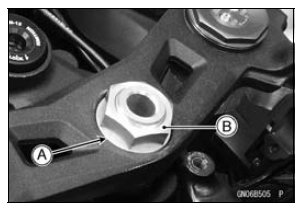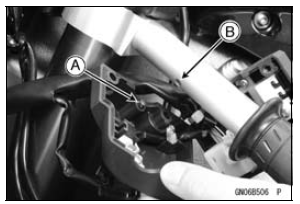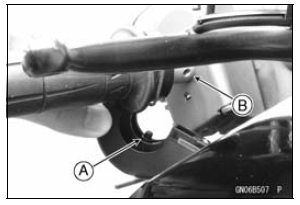

Apply a non-permanent locking agent to the threads of the handlebar positioning bolts and tighten them.
Torque - Handlebar Positioning Bolts: 9.8 N┬Ęm (1.0 kgf┬Ęm, 87 in┬Ęlb)
NOTE
Tighten the steering stem head bolt before tightening the upper front fork clamp bolts and handlebar clamp bolts.

| WARNING If the handlebar does not turn to the steering stop it may cause an accident resulting in injury or death. Be sure the cables, harnesses and hoses are routed properly and do not interfere with handlebar movement (see Cable, Wire, and Hose Routing section in the Appendix chapter). |
Fit the projection [A] into a hole [B] in the handlebar.
Torque - Switch Housing Screws: 3.5 N┬Ęm (0.36 kgf┬Ęm, 31 in┬Ęlb)

Fit the projection [A] into a hole [B] in the handlebar.

 Handlebar Removal
Handlebar Removal Frame
FrameWarning/Indicator Lights
: When the
transmission is in
neutral, the neutral indicator light goes
on.
: When the
headlight is on high
beam, the high beam indicator light
goes on.
: When the
turn signal switch is
pushed to the left or right, the turn signal
indicator light blinks. ...
Cable, Wire, and Hose Routing
1. Clamp (Hold the regulator/rectifier lead. Run the lead inside of the
installation hole.)
2. Clamp (Bend down the clamp, and hold the main harness and the vacuum hose
(equipped
models).)
3. Clamp (Hold the air intake solenoid valve lead (equipped models).)
4. Run the vacuum hose under ...
What if I am not Satisfied With My Warranty Service?
If you arenŌĆÖt satisfied with your dealershipŌĆÖs repair work or operations, it
is best to
discuss the situation with the appropriate dealership manager. If you have
already
done this, then contact the dealershipŌĆÖs owner or general manager to request a
review of the issue.
If you are un ...